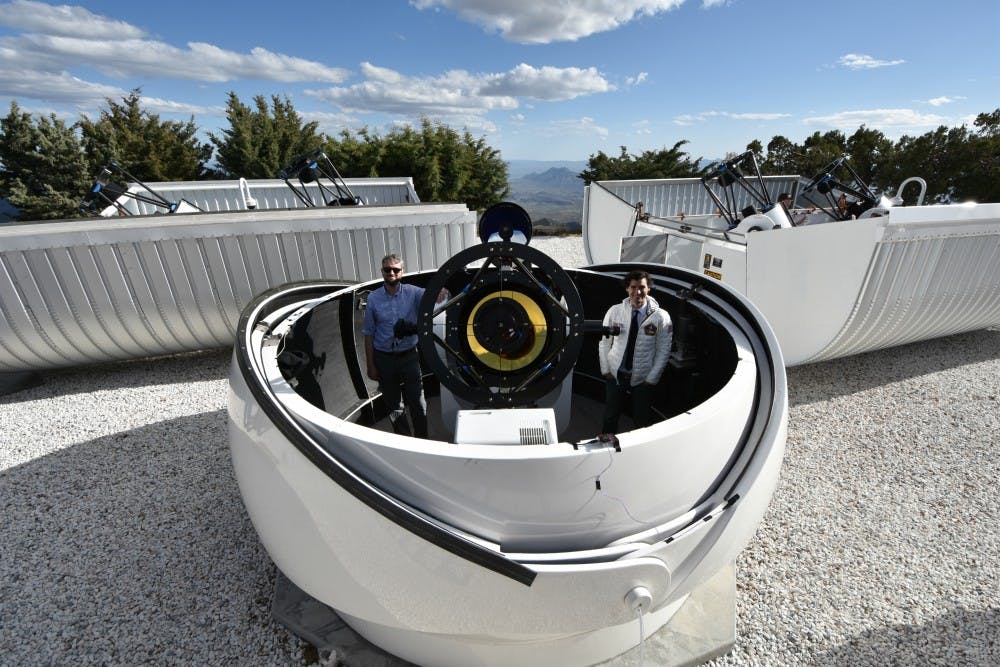
Penn researchers are coming close to finding the next Earth.
Astronomy assistant professor Cullen Blake and graduate student David Sliski have joined a group astronomers across the nation that produce an array of low-cost telescopes. These astronomers hope to discover planets orbiting stars other than the Sun. As Penn representatives, Blake and Sliski join a group of astronomers from various universities across the country to make up the Minerva project, a project that operates five robotic telescopes.
Blake and Sliski’s telescope, the Minerva-Red, was recently installed at the Fred Lawrence Whipple Observatory in Amado, Arizona. Their focus on Minerva-Red, is a specific aspect of the entire project. Blake described the two as “sister projects that share some resources.”
“Our specific goal here is to try to find planets orbiting the near stars to the sun,” Blake added.
Near stars are smaller, cooler stars that radiate infrared light, which cannot be studied well with conventional telescopes. He said that if you figuratively boxed the sun, there would be “many dozens” of these near stars captured in the box.
The Minerva-Red marks a change in focus in the search for Earth-like planets, as historically astronomers have searched for these planets around stars similar to the Sun in our solar system. This different approach that Blake and Sliski have taken is not only more productive, but also cheaper.
“Professor Blake had this very brilliant idea of how to use mostly off-the-shelf components to build an instrument to do this very high precision work and to try to find Earth-like planets around these smaller stars,” said Sliski.
He added that little time was needed to build the Minerva-Red and get it started on searching for planets.
“Usually, you have an idea, you apply for money, you test a lot of things out and you potentially stall and then you test it out for a while longer before you get [science] and that process can take 5-10 years,” Sliski said. “I was hired in October and we already have the telescope up on the mountain and we hope to have the instrument [that measures the telescopes’ readings] there in September.”
Both Blake and Sliski are optimistic of finding the next Earth through Minerva-Red and future research. Although no definitive twin planet has been found, similar planets to Earth seem to be more common than previously thought. Blake mentioned that statistics point “towards a general picture that planets are very, very common”.
“The idea is that we are just reaching the tip of this iceberg and realizing that it’s much bigger,” he added. “These little stars do have tons of planets that are like Earth, and by like Earth, I mean planets that are predominantly made of rock, as opposed to gas.”
Both Blake and Sliksi believe that most people would share their enthusiasm in finding the next Earth. Such an accomplishment, they believe, would interest anyone, regardless of their attitude towards telescope and other space-related missions.
“The feedback we get from the general public is fantastic,” Blake said. “It’s because I think people can relate to a planet, something we live on. We learned about the planets in elementary school. We study facts about these planets.”
“If our telescope, regardless of its cost — in this case it’s very inexpensive in comparison to other things — [achieved] the simple feat of discovering a world that could harbor life like ours, [anybody] would be excited about [it],” added Sliski.
The Daily Pennsylvanian is an independent, student-run newspaper. Please consider making a donation to support the coverage that shapes the University. Your generosity ensures a future of strong journalism at Penn.
DonatePlease note All comments are eligible for publication in The Daily Pennsylvanian.





